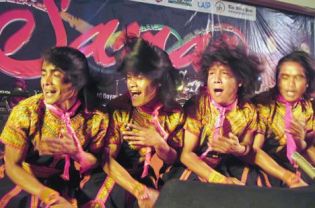
The Saman Saraingi (all-night Saman) was held at the Dayan Dawood Academy Activity Center at Syiah Kuala University in Banda Aceh on Saturday night to celebrate the inauguration of the executive board of the Gayo Lues Students Association. It was the first time the dance had been performed outside of Gayo Lues.
Two 13-strong teams of men — a group of students from Gayo Lues who are studying in Banda Aceh and a troupe invited from Blang Keujeuren in Gayo Lues — performed the dance in turns.
Accompanied by the beating of the rapa’i , a large tambourine, the teams responded to each other in song, while performing the intricate movements characteristic of the dance.
Some 10,000 people, comprised of students, academics, artists, tourists and the general public, packed the activity center hall as the teams of colorfully attired dancers took turns to perform.
The Saman involves an odd-number of men, sitting in a single row, singing while performing carefully coordinated and synchronized movements.
Saturday evening’s event featured the original Saman dance, with exclusively male performers and singing in Arabic and Gayo languages.
The dance is said to have been created hundreds of years ago by Syekh Saman, an Islamic scholar from Gayo, to spread the teachings of Islam.
“I have never seen this version before, it really is extraordinary” said Eliana, a spectator and resident of Banda Aceh. “The Saman dances I have seen performed before were nothing like this.”
The performers had their first brief reprieve after one hour, when two women came to fan the teams. According to Rajab Bahri, a Saman expert from Gayo Lues, the fanning is considered a form of support for the women’s favorite team.
The event also featured a poetry reading from a Gayo Lues poet and another Saman dance by 13 long-haired men, who were accompanied by four men in a trance who attempted to stab themselves with a rencong , or traditional dagger.
“All Saman dancers are men, and there is always an odd number, indicating that one of them is the iman,” Rajab said. “It is never danced by women and the original dance is rich with advice and encouragement to do good.”
Speaking to the crowd, Ibnu Hasim, the Gayo Lues district chief, said that in the region there were two types of Saman: the Saman Saraingi and the Saman Roaingi.
“The Saman Saraingi is a dance played between teams from two neighboring villages, and is primarily for entertainment,” he said. “The Saman Roaingi is designed to foster new friendships and is usually held between teams from villages that are far away from each other.”
He said the Saman dance had been registered with the United Nations Educational, Scientific and Cultural Organization for consideration as intangible cultural heritage. Ibnu added that he was confident it would be recognized by Unesco as it “is in the top position from 200 dances from around the world.”
The Aceh provincial government said it planned to hold a similar event in Jakarta.
Source: thejakartaglobe.com